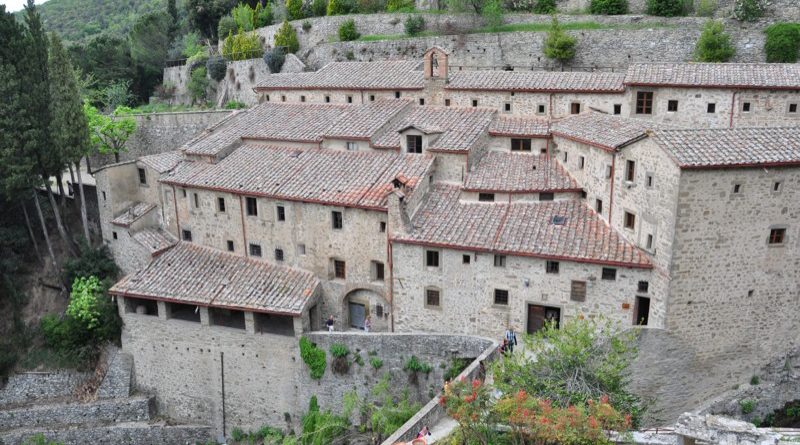Italy 2012 – Exploring Cortona
This morning we were awakened by the sound of the 9:30am town bells and an iPhone alarm, perfectly simultaneously. I shook Rich to get him to wake up and turn off his alarm, but he claimed it was just the bells. I said no, there’s an alarm going off. No, he said, it’s the bells. After a few minutes the bells stopped, but the iPhone was still going. And even though it sounded like it was in our bedroom, several minutes of searching for any idevice that might possibly have an alarm, we discovered the alarm was actually in the apartment next to us. From what I can tell, this apartment used to be larger, and at some point was divided by a CMU (cinder block) wall. And that wall transmits sound quite well. I actually discovered that at 2am when I woke up to a man speaking Italian right next to my bed (or so it sounded).
Our first task this morning was to find an Internet cafe, where the Internet actually worked. This proved to be surprisingly difficult. Even the cafe we were at the evening before didn’t seem to have wifi anymore (but it does now). I’ll spare you the details, but suffice it to say we spent over an hour trying to get Internet just to check in on outside life. After morning coffee, we were off to lunch. (Meals seem to dictate our schedule for the rest of the day.). We had a fabulous lunch at Bar 500, a little street cafe on the main drag. In fact, this particular main drag is the only flat (that is, not on a steep hill) street in the entire city of Cortona. If you go there, I highly recommend the tapas platter, which is a very large plate of: melon wrapped in prosciutto curo, caprese salad, cheeses, arugula salad, and tomato bruschetta. Rich had a very good prosciutto pizza.

After lunch, we met Giovanni for our tour of Cortona. Giovanni was Rick Steves’ tour guide for Cortona and the surrounding areas, and he did a brilliant job. He was knowledgable, entertaining, easy to understand, and he toured at a good pace. If you’re in Cortona, give him a call.

We started our tour outside the town walls at a hermitage built for St. Francis of Assisi by his friar friend Elias in the 11th or 12th century. It really can’t be described, you have to see it. It’s built of stone into the hillside and has a steep river, almost a waterfall, running through it. Over the years, a monastery was added, with rooms for friars and travelers. There was a small kitchen, the layout of which was brilliant for keeping warm in the winter and letting the breeze through in the summer. The hearths were low, with the fires built on top, and metal racks on top like camp stoves to bring it all to a working surface height. There was also a chapel, and the tiny, windowless room that was the hermitage itself. Giovanni explained the local Italians go to the hermitage to relax and unwind in their free time, because living in crowded, ancient walled towns makes them a little crazy without some kind of escape.

If you’re up for a hike, there is a dirt road beginning at the hermitage that winds around the surrounding hillsides. That is on my agenda for our next trip. We also took a troll down a Roman road that was thousands of years old.
Then we took a trip over to the basilica of Santa Margherita, which according to our tour guide, was new. Around here, a building is new if it was built within the last 250 years. Although the church was built in the 12th century, it had been remodeled significantly in the 17 or 1800s and was therefore new by Italian standards.

I won’t go into detail to describe each of the churches we visit, but suffice it to say they’re all different and all breathtaking. I don’t think I’ll get tired of the churches on this trip. Oh, and to point out the waves of Catholic guilt that flow over me when entering any of the churches for my failure to continue practicing Catholicism in my adulthood. Those Catholics get you we their guilt coming and going.
Giovanni also pointed out a fort at the top of the hill that the locals were not at all fond of, also “new,” where the Umbrians watched over the town of Cortona. The watching was not for protective purposes, but for control. There is a very long history of Cortona – which is on the border of Tuscany near Umbria – being constantly sacked and conquered by the Umbrians and struggling for its independence and associations with Tuscany again. Siena was a long-time ally in this battle over the centuries, which didn’t end until Italy as we know it today was formed in 1846. (Holy late republic, batman! Particularly considering the Romans kind of invented it, after the Greeks, thousands of years ago…). To this day, there is a strong rivalry between the Tuscans and Umbrians.
We then returned to the town of Cortona, which was originally established by the Etruscans in the 7th Century BC. However, they’ve recently found the remains of an Etruscan graveyard from the 11th Century BC, so the area has likely been settled at least since then, although no structures from that period exist or have been discovered – just bones.

The 7th Century Etruscans built the original city walls in that era out of giant blocks of stone, at least two to three feet high and maybe 5 feet wide, and I don’t know how deep. Over the years the city was repeatedly raided and destroyed then repaired/rebuilt, until the city walls were rebuilt in the middle ages (about the 12th Century) out of smaller round stones, which were really just the broken fragments of the original Etruscan stones. the city was sacked by the Umbrians several times since then, and each war led to new development right on top of the old, a cycle that was ongoing for hundreds of years.
Which leads me to a tangential musing: I keep trying to picture how these cities would have looked “originally,” but of course there is no such thing as original here. There is simply the way the cities looked and felt and lived at different points in time. There is no “original” version of something that, for all practical purposes, was always there.

For example, once inside the city Giovanni took us into the “back rooms” of a pharmacy on the main drag of Cortona. (One of the benefits of a private tour.) The pharmacy was small but very modern, and we went through the staff only door down to the lower level below the street. There were file cabinets and iMacs on desks like any office, but half of the office was in an old Roman (early AD) arched passage. But that wasn’t what Giovanni wanted to show us. We went down another flight of stairs to a similar office area – more iMacs and file cabinets – where a large part of one corner was occupied by an Etruscan well and stone doorway, likely put there several centuries BC when that floor was at street level. Giovanni also took us to an archeological site in the middle of the city (that apparently only he has the key for) that was discovered in the past few years when a building was undergoing renovations. The site is a (now underground) spring located in an ancient Etruscan tunnel, later framed by a large, thick archway when the spring was built into the Roman aquaduct system. Both were completely buried until just a few years ago.
We also toured two of the town’s three churches, while receiving a brilliant (if not brief) Catholic art history lesson. The most interesting tidbit was that Baroque art was generally very boisterous and happy, but after the reformation, Catholics suddenly became very serious (and depressed) artists, with paintings dominated by large, ugly, dominating holy figures and groveling, humble little humans. The intersections of art, religious politics, and culture are fascinating.

 After our tour, we went back to our (so far only reliable) Internet cafe to call Mo. Then we had a delicious dinner at Trattoria La Grotta, which is the restaurant directly below our apartment. Very good. By the time we finished our 8pm dinner it was past 10, so we headed upstairs for bed.
After our tour, we went back to our (so far only reliable) Internet cafe to call Mo. Then we had a delicious dinner at Trattoria La Grotta, which is the restaurant directly below our apartment. Very good. By the time we finished our 8pm dinner it was past 10, so we headed upstairs for bed.
– Posted using BlogPress from my iPad




